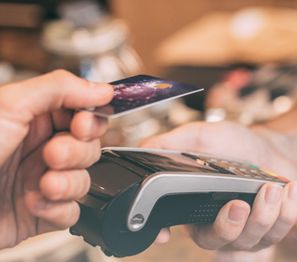
Swipe, tap and thrive: Why every single-location restaurant needs a POS
Learn why a POS system is essential for small quick service restaurants and which features help streamline orders, boost sales, and keep your café running smoothly.

To run a successful business today, you need to understand how payments work, especially when customers expect fast transactions. Payment terminals are the ones to make that possible—they allow you to accept various payment methods, including credit cards, debit cards and digital wallets.
Payment terminals have evolved significantly, accommodating new payment technologies and security standards. This guide explains the types of terminals, how they work and how to choose the right one for your business.
A payment terminal is an electronic device that securely processes transactions between the merchant, the customer's payment method and the payment processor. Also known as credit and debit terminals or card machines, they're a cornerstone of modern commerce, accepting multiple payment options like chip-and-PIN cards, contactless cards and mobile wallets.
In Canada, where digital payments are widely used, these terminals are an indispensable asset for businesses of all sizes. They help streamline operations, reduce errors due to manual cash handling and protect sensitive customer information during transactions. Whether you're running a physical storefront or a mobile service, the right terminal can enhance how you serve customers.
Payment terminals come in various forms, each tailored to specific business needs. The right type depends on your business size, location and customer preferences. Here are the most common types of payment terminals:
Countertop terminals are designed for businesses that conduct high in-store transactions and require a dependable stationary device. Ideal for retail stores, restaurants and service centres, these devices connect to a power source and the internet via Ethernet or phone lines, and support various payment methods, including chip-and-PIN, tap-to-pay and swipe transactions. Some models also offer advanced features, such as receipt printing and integration with POS systems to streamline operations further.
Wireless payment terminals provide mobility without sacrificing functionality. They process payments using Wi-Fi, Bluetooth or cellular networks, letting you accept payments anywhere and enhancing the customer experience. These terminals are great for restaurants with tableside service, pop-up shops and outdoor events, offering the same payment options as countertop terminals, but with the flexibility to move around.
Mobile terminals pair with a smartphone or tablet via Bluetooth to process payments. They are compact, affordable, function through apps and support payment methods like chip-and-PIN, contactless and mobile wallets. These terminals are perfect for small businesses or entrepreneurs, such as service providers, food trucks and freelancers who need a lightweight, cost-effective way to accept payments. Although not as feature-rich as countertop or wireless terminals, mobile payment terminals provide an entry-level solution for businesses looking to expand their payment options.
A virtual terminal lets you accept payments through a computer or tablet without physical hardware. Ideal for remote or online transactions, they are accessed through a secure web interface and allow manual entry of customer payment information. While they don't support tap or chip card transactions, virtual terminals are great for handling recurring or card-not-present payments.
Integrated POS terminals combine payment processing with a complete point of sale system, offering a unified solution for managing sales, inventory and customer data. These systems are ideal for multi-location retailers or high-traffic restaurants as they support different payment methods and offer advanced features like customer relationship management and detailed sales reporting. While more expensive, integrated POS terminals provide unmatched efficiency and scalability for growing businesses.
Payment terminals securely transmit payment information between the customer, the merchant and financial institutions.
When a customer initiates a purchase, the terminal prompts them to choose their preferred payment method—inserting a chip-enabled card, swiping a magnetic stripe card or tapping a contactless card or mobile wallet. Each method follows its own secure processing protocol. In Canada, contactless payments, including those made with NFC-enabled devices, are popular for their convenience and speed. The terminal communicates directly with the customer's card or device to retrieve payment information.
After a payment method is selected, the terminal encrypts the customer's payment data to protect it during transmission and sends it to the payment processor for verification—card details, sufficient funds or credit availability. This encryption process prevents fraud and ensures compliance with security standards like PCI DSS. Modern payment terminals, like Moneris Go, use advanced encryption technologies like tokenization to ensure sensitive information is never exposed.
Once the transaction is validated, the terminal receives an approval or decline message. If approved, the payment terminal finalizes the transaction and provides a printed or digital receipt. While this step may include additional features like tip entry or email receipt options, the seamless completion of this process ensures both the merchant and customer have a record of the transaction.
The final step involves settling the transaction—funds are transferred from the customer's account to the merchant's. While this occurs behind the scenes, payment terminals ensure transaction data is accurately logged and forwarded for settlement.
Since digital payments are popular in Canada, understanding this flow can help optimize operations and provide faster access to funds. Payment terminals streamline this process, making them essential if you're managing multiple daily transactions.
The right payment terminal ensures smooth transactions, satisfied customers and efficient operations. Whether you run a bustling retail store or a mobile business, the terminal you choose should align with how and where you sell. Here are the key factors to consider:
The type of business you operate and the volume of transactions you process play a major role in choosing the right payment terminal—especially during peak transaction periods.
Diverse payment options enhance the customer experience. To stay competitive, choose a terminal that supports:
Your business environment will determine whether a fixed or portable payment terminal is better.
Additionally, review the terminal's connectivity options—whether it operates via Ethernet, phone lines, Wi-Fi, Bluetooth or cellular networks. Reliable connectivity is crucial to avoid transaction delays in high-traffic settings.
Look for a payment terminal with intuitive controls and clear prompts, like the Moneris Go terminal that integrates seamlessly with your existing setup. It reduces the learning curve for employees and minimizes errors during transactions. Integration can also provide valuable insights into sales and inventory, helping streamline operations.
Security is a critical part of payment terminals. These devices are built with advanced security measures to protect both merchants and customers during every transaction, such as:
Proper setup of a payment terminal ensures smooth transactions and avoids errors. Whether you're setting one up for the first time or training staff, a clear understanding of the process can improve efficiency and customer satisfaction.
First, ensure the payment terminal is configured to meet your business requirements. Connect the terminal to a reliable power source and choose its communication method—Ethernet, Wi-Fi or a cellular network. Most terminals include a guided setup for language preferences, time zone settings and connection configurations. Next, install any required software or updates from your payment processor for the latest security protocols and features. If your terminal integrates with a point of sale system, ensure the connection is established for seamless data transfer. Finally, run a test transaction to confirm it functions correctly and identify and resolve potential issues before serving customers.
Training staff on using the terminal is as important as the initial setup. Provide clear instructions on how to initiate transactions, select payment methods and handle errors or declines. Most payment terminals display prompts that guide users through each step, making them easy to operate. Make sure your staff understands how to position cards or devices for contactless and chip-based transactions, and how to offer print or email receipts. Encourage them to familiarize themselves with built-in customer support features like error code explanations or quick troubleshooting tips.
Clean the card reader and touchscreen regularly to prevent malfunctions. Stock adequate supplies and ensure they are loaded correctly for terminals with paper receipt capabilities. Use the diagnostic tools in your terminal to assist with troubleshooting connectivity issues or software errors. For more complex issues, contact your payment processor's customer support. Quick problem resolution keeps downtime to a minimum and preserves the customer experience.
Setting up and using a payment terminal correctly equips your business to provide fast and reliable service. This leaves a positive impression on customers while maintaining operational efficiency.
Even the most reliable payment terminals can encounter occasional issues. Being prepared to address these problems ensures minimal disruption to your business. Here are a few common issues and how to fix them:
Addressing these common issues helps reduce downtime and maintains a positive customer experience. Regular maintenance and staff training can also help prevent many problems.
The future of payment terminals is shaped by innovation, adaptability and the need for seamless, secure and diverse payment experiences. As consumer preferences shift, terminals are evolving to support advanced technologies like biometric authentication, AI-powered fraud detection and blockchain payments. With the rise of digital wallets, contactless transactions and QR code payments, physical hardware is becoming more integrated with software solutions, offering businesses greater flexibility and insights.
Sustainability is also shaping the terminal design with eco-friendly materials and energy-efficient operations. For businesses, future-ready payment terminals won't only process payments—they'll act as multifunctional hubs with inventory management, customer loyalty programs and data analytics to drive growth in a digital economy.
Payment terminals are more than just devices—they are vital tools that enhance customer experience, streamline operations and drive business growth. At Moneris, we understand the needs of Canadian businesses and our commerce solutions are designed to help you accept various payment methods seamlessly. Moneris offers tools for businesses of all sizes to support your long-term success.
A payment terminal is a device that lets businesses accept and process payments from credit cards, debit cards and digital wallets. It ensures secure transactions by encrypting and transmitting payment data between the customer, the merchant and the payment processor.
Payment terminals include countertop, wireless, mobile, virtual and integrated POS terminals. Each type serves specific business needs. Find out which terminal is right for you with Moneris; our expert staff can help you choose.
Payment terminals protect sensitive payment information using encryption, tokenization and compliance with security standards like PCI DSS. Features such as tamper detection and secure firmware updates further enhance their security. Read more about our fraud detection tools and practices here.
Most modern payment terminals, like the Moneris Go devices, are equipped with NFC technology to process contactless payments. This includes tap to pay with credit cards, debit cards and mobile wallets like Apple Pay and Google Pay.
You need to consider your business transaction volume, payment method preferences, connectivity options and security features. Make sure it aligns with your business operations and customer needs.

Learn why a POS system is essential for small quick service restaurants and which features help streamline orders, boost sales, and keep your café running smoothly.

Discover the best POS systems for small retail businesses. Learn how to streamline inventory, boost sales, and improve customer service with the right POS solution.

Learn what card testing fraud is, how it targets your e-commerce site, and the best practices you can use to detect, block, and prevent attacks before they impact your business.

What is contactless payment and how does contactless payment work? Discover how this technology speeds up transactions and improves customer experience with secure, fast processing. Learn what contactless payment is and how contactless payment works to streamline transactions. Find out how it benefits your business with faster and more secure payments.